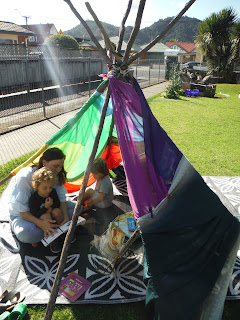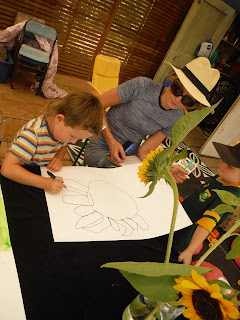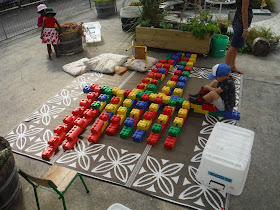Transition to school and how early childhood services 'prepare' children for school are continuously a hot topic of conversation for both parents and caregivers and teachers alike. Recently I have had a number of conversations in regards to this topic with whānau from Kindergarten so I thought it would timely to re-share a blog I wrote a few years back.
We often get asked how we support children in getting ready for primary school. How do we teach them their ‘ABC’s and 123’s?’ and there is the occasional question thrown our way in regards to whether we run a ‘four year old or school prep’ programme. The response that we have to these queries is often meet with surprise and astonishment.
As a team at Mairtown we are very clear about how we view ‘school readiness’ and how this is implemented into our programme and the environment. This view is underpinned by a number of aspects which include building on children’s social competencies, developing independence, and developing good attitudes towards risk taking and learning.
This is supported by plentiful opportunities for free play, lots of hands on ‘real’ experiences, using the arts as a language for children to express their ideas and knowledge, allowing children to revisit learning experiences over and over and through having an environment that is predicable (to name just a few things).
We believe that if we support children in a holistic manner then they will thrive, their self-confidence will grow, which will in turn give them an array of skills that they can utilise not only during their transition to school but also throughout their lives.
I thought I would break a few of these aspects down briefly. So firstly, why is developing social competencies important for getting ready for school? Developing positive social competencies supports children in working well with others, it helps with self-regulation and communicating feelings. All these skills are welcomed warmly when children enter their new entrant classroom.
Rubin and Rose-Krasnor (1992) define social competence as, “the ability to achieve personal goals in social interaction while simultaneously maintaining positive relationships with others over time and across situations.”
As teachers of young children we foster developing strong social competencies by celebrating and giving a lot of positive praise when we see children working hard on regulating their emotions, communicating their feelings, listening, negotiating, sharing, turn taking and showing empathy. Play is one of the best ways that children explore different ways that social competencies work.
Play is something that we celebrate and don’t take for granted as we know that children use play to explore many different concepts, life skills and learning areas. It is disappointing when we hear comments about how children are ‘just playing’ so we will defend play and its greatness by explaining the importance of it, how this supports learning and preparation for school. Play involves working together, concentrating and following through with tasks, being creative, exploring language and self-expression, building on confidence, developing gross and fine motor skills to name just a few things.
Davis (2014) acknowledges that "Play isn’t some sort of soft approach before the ‘real’ learning begins. That idea is a hangover from education’s industrial era. Play has been consistently described across time as central to cognitive, language, cultural, and social development.”
At Mairtown Kindergarten we thoughtfully provide an engaging environment, follow children’s interests, actively listen to the child, give them time and space and allow children the access to authentic and real experiences. By doing this we are showing that we value them and the flow on effect is that they feel empowered and encouraged to give things a go. Having a positive attitude towards trying things out is also going to be of great value in the classroom and through out life.
“Children understand and remember concepts best when they learn from direct personal experience.” (Joseph Cornell)
Having a positive attitude towards risk taking and doing things that make you feel a little worried creates lots of empowering learning experiences. We create an environment that promotes risk taking, encourages children to assess risk and work out what is appropriate etc. We gently assist them through these experiences, small steps to large leaps.
"Risk perception is like a muscle that needs to be developed and flexed." (Blincoe, 2015)
Risk taking is not only tree climbing and rock jumping, risk taking can be supported in many areas for example the simple act of putting pen to paper, asking another child to play with them and using the hot glue gun after burning the end of their finger. All of this helps develop a positive attitude towards risk taking and is wonderful for lifelong learning.
“Successful learners have positive beliefs and attitudes towards learning. They are not afraid of new experiences and can see learning opportunities in many different settings.”
(Alberta, 2002)
A predictable environment, full of open ended resources is another tool that we use to support our children in developing skills and knowledge to support their ‘school readiness’. By providing an environment that is predictable this nurtures a strong sense of belonging for our children and their families as they quickly learn where they can find things and access resources to support their interests. Open ended resources are so wonderful because they support creative thinking and meaningful engagement for our children.
Along with this we also leave resources and experiences set out for lengthy periods of time to allow children to revisit experiences over and over again. We know that new learning is influenced greatly by past learning and children’s developing knowledge is fostered greatly when they have the opportunity to continually revisit learning experiences. “If we continually change the materials, experiences and resources that children play with, then we risk short-changing children’s experience. While some change is important to maintain children’s interest and introduce new ideas, change for the sake of change reduces the chances children have to re-engage with and master materials and ideas. Children will benefit more from deep involvement with a few well-chosen experiences than from superficial involvement with many.” (NQS-PLP, 2012).
So while children are involved in all this play based learning in our thoughtfully set up environment they are engaging with many different learning concepts that they will take with them to primary school. They are playing with mathematical, scientific and literacy concepts to name just a few things. Children are more motivated to engage in meaningful learning experiences when they are having fun and their interests are acknowledged.
We want our children to leave Mairtown Kindergarten capable and competent, with a wonderful attitude towards learning and risk taking. We want them to have a bag of tricks full of skills and knowledge that will give them the confidence to ‘give things a go’ and not be afraid to not always succeed at a task, knowing that in failure comes rich learning.
One of the biggest and most frustrating comments that we hear every so often is, ‘Now my child is heading off to school to do real learning!’ At Mairtown we have children who are living and breathing meaningful learning every day and we are proud to be providing them with these opportunities. This is the time when children are developing lifelong learning skills, attitudes and ways of being that will support them for many years to come. We take our jobs of fostering this very seriously, we are professionals who care deeply about what we do and in no way want to stifle our children’s desire to learn about and question their world. Yes we want our children to know how to write their names, recognise colours, shapes and how to count to ten. However more importantly we want them to feel empowered and valued and we whole heartedly try our hardest to accomplish this.
“The goal of early childhood education should be to activate the child’s own natural desire to learn.” (Maria Montessori)
Hei konā mai,
Zair









































































